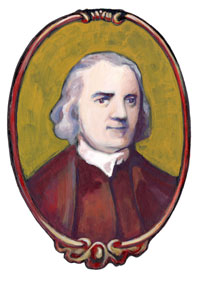Math Challenge
Choose your grade level:
Elementary School
Middle School
High School
Video & Photos
September 2008
A Salute to the Troops Game Video
July 2008
All-Star Tee Ball Game Video
All-Star Tee Ball Game Photo Essay
June 2008
Eighth Season Opener Video
Eighth Season Opener Photo Essay
March 2008
White House Easter Egg Roll 2008
December 2007
Barney Cam VI: Holiday in the Parks
December 2007
Barney Cam VI Photo Essay
June 2007
Tee Ball on the South Lawn Photos

 White House Dream Team: Samuel Adams
White House Dream Team: Samuel Adams
|
Long before Thomas Jefferson drafted the Declaration of Independence in 1776, Samuel Adams wrote a school paper about the right for fairness and justice in government. Samuel developed his ideas about freedom while studying the theories of John Locke at Harvard College in the 1740s. After completing his studies, Samuel returned to Boston, Massachusetts to work for his father. He began to question the fairness of the laws imposed by the governor, who was appointed by the British government. Samuel and his father spent several years trying to prevent British officials from taking their home and land. Samuel believed the colonists had a right to elect their own government officials and he began to convince others about their rights for fairness, justice and representation. He wrote newspaper articles and essays and promoted his ideas at taverns and meetings. As a result he formed the Country Party, which included farmers who supported his ideas. Conflict with colonists and the British Government grew worse in the 1760s and 1770s when the British Parliament imposed new tax laws on the colonists. Samuel and the members of the Country Party opposed these laws. Samuel organized a group called the "Sons of Liberty," who resisted the tea tax by secretly dumping tea into Boston harbor in the famous "Tea Party." Samuel saw the need to expand his cause, and he began to make his case for independence to John Adams, his second cousin, and a wealthy merchant named John Hancock. Samuel proposed a meeting with representatives of all the colonies to discuss their problems with the British Parliament. The Continental Congress first met in Philadelphia in 1774. Just as he had in Boston, Samuel promoted his ideas for independence with the other delegates. Two years later, the Continental Congress met again in Philadelphia. They adopted the Declaration of Independence on July 4, 1776, and Samuel signed it. Samuel continued to represent the people of Boston, and he ultimately served as president of the Massachusetts Senate. He voted for the Constitution in 1788, but strongly supported the need for a bill of rights. He spent the rest of his life as a voice for reform, and he died in Boston in 1803. Samuel's strong belief in independence and his ability to persuade support for the cause of freedom earned him the name "the Father of the American Revolution." Brain Challenge:
Want to learn more? |
Born September 27, 1722 in Boston, Massachusetts Died October 2, 1803 in Boston, Massachusetts Legacy "Father of the American Revolution” Character Trait Patriotic Baseball Players Jackie Robinson Roberto Clemente Lou Gehrig Athletes Red Grange Jesse Owens Wilma Rudolph Patriots Samuel Adams Esther De Berdt Reed Lemuel Haynes Teachers Mary Jane McLeod Bethune Américo Paredes Anne Sullivan Macy Founders John Jay Clara Barton Booker T. Washington Authors Laura Ingalls Wilder Theodor Seuss Geisel Elwyn Brooks White More Artists Henry Tanner Gilbert Stuart Mary Cassatt |


 Samuel Adams
Samuel Adams